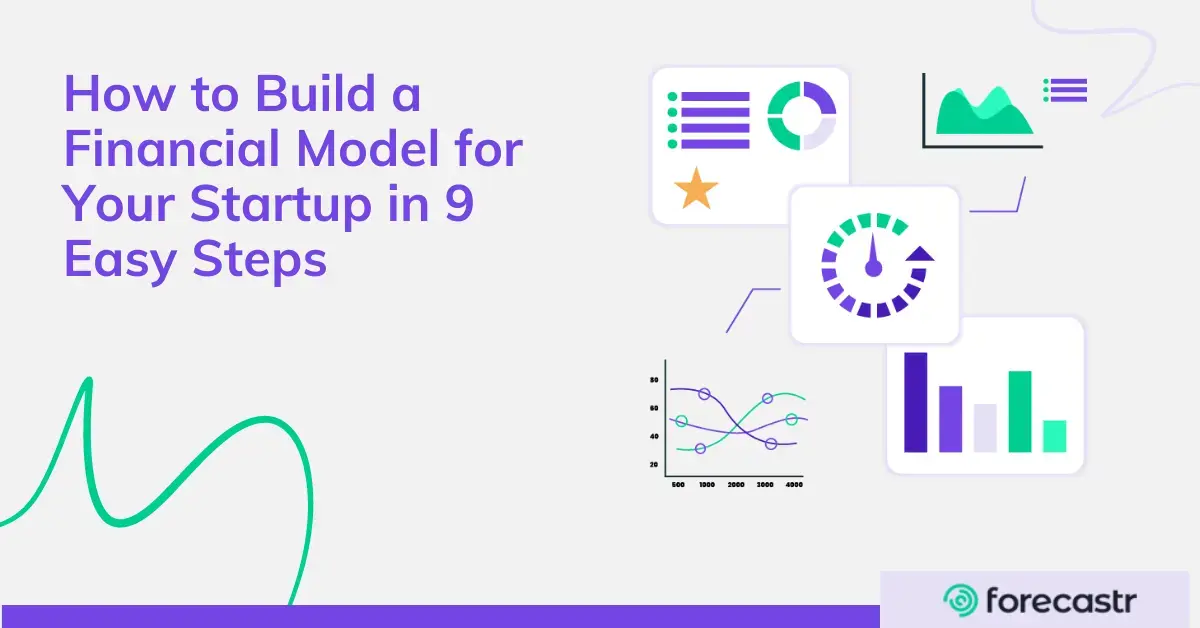How to build a great forecast: Key startup metrics and techniques
At Forecastr, we know that forecasting metrics is an essential part of running a successful startup. Accurately forecasting your startup's growth and...
8 min read
 Steven Plappert
June 21, 2023
Steven Plappert
June 21, 2023
A financial model is a critical tool that every startup and SMB needs to leverage. A model gives you a deeper understanding of your business. It lets you plan for the future. And it helps you convince investors and stakeholders that your business is worth investing in.
However, for many founders and decision-makers building an accurate financial model from scratch is a major undertaking. This is especially true for people who don’t have much background in finance.
In this post, we’ll cover 6 steps you should take before you start to build your financial model. Complete these steps before you build to ensure that your model is accurate, useful, and effective.

Before you can build a solid financial model, you need a thorough understanding of your business model. This means grasping not just how your business makes money, but also how it functions on a deeper operational level.
Here are a few key elements to consider:
Revenue streams
Understanding how your company generates revenue is foundational. Identify all the different ways your business generates revenue. This could be through product sales, service fees, subscription fees, advertising revenue, or any other method specific to your business. For every stream, understand the current volume of prospects, the conversion rate, and the cost of making a sale.
Cost structure
Your cost structure is just as important as your revenue streams. Costs may be divided into fixed costs which do not change with the level of output (like rent), or variable costs which do change with output (like cost of materials or transactional fees). Understand all of your expenses to predict how costs will evolve as your business scales.
Value proposition
Your value proposition is the unique set of benefits that differentiates your product or service from others in the marketplace. It’s what makes customers choose you over your competitors. Evaluating your value proposition against your competition can help you develop an effective pricing strategy, which directly impacts your revenue.
Customer segments and channels
Who are your customers? How do you reach them? When you dig into your customer acquisition, you’ll likely find different segments, each with its own buying lifecycle, price sensitivity, and preferred communication channels. Factors like these can significantly impact your sales forecast and projected marketing budget.
Key partners and resources
Recognize who your key partners are, such as suppliers, distributors, and strategic partners. Account for key resources you rely on, such as intellectual property, capital, and human resources. Your relationships with partners, and your ability to effectively manage them, can influence both your revenue and your costs.
Key activities
Identify all of the essential activities that your business performs to deliver its value proposition. This could include things like product development, marketing strategies, sales processes, customer support activities, and more. Your key activities often make up your major cost centers and your biggest revenue streams.
Understanding these aspects of your business model allows you to create a financial model that accurately reflects your actual operation. It helps you identify the key drivers of your financial performance, which you need to monitor and manage to improve your results.
Identifying the metrics that drive your business performance is vital when you’re creating a financial model, and it becomes even more important when the time comes to start raising capital.
Your key metrics or Key Performance Indicators (KPIs) are quantifiable measures that are used to evaluate whether or not your company is achieving its objectives. The best metrics to measure will depend largely on your business model.
These are some common elements that you may want to include:
Customer Acquisition Cost (CAC)
This is the total cost of acquiring a new customer, including all aspects of marketing and sales. It's a crucial measure in determining the viability of your customer acquisition strategies and ultimately drives your bottom line.
Customer Lifetime Value (CLV)
This is the total revenue that you can expect from a customer over the lifetime of their relationship with your company. It provides insight into how much you can afford to spend on acquiring new customers and retaining existing ones.
Customer Churn Rate (CCR)
Churn rate is the percentage of customers who stop using your product or service over a given period. It’s critical for SaaS companies and other businesses with a subscription-based revenue model. A high churn rate can indicate a lack of product-market fit, which can severely impact your revenues over time.
Conversion Rate (CVR)
This is the percentage of potential customers who perform a desired action (like making a purchase or signing up for a trial). Conversion rates can help you understand the effectiveness of your sales and marketing strategies.
Average Order Value (AOV)
This is the average amount spent each time a customer places an order. By tracking this metric, you can develop strategies to encourage larger orders, thus increasing revenue.
Gross Margin (GM)
This is the percentage of total sales revenue that your company retains after incurring the direct costs associated with producing the goods and services sold. A higher gross margin typically indicates a more financially sound business.
Burn rate
Particularly relevant for startups, this is the rate at which your company is spending its capital. Keeping a close eye on your burn rate helps ensure you don't run out of money unexpectedly.
These are just examples of some common KPIs. You’ll need to determine the specific metrics that matter most depending on your business model and industry. For a deeper understanding of the metrics and benchmarks, you’ll need to show investors during fundraising, check out this post about fundraising metrics. When you’re building a model, it’s wise to include both the metrics you’ll use to optimize your business and the metrics you’ll need for fundraising.

Setting clear objectives for your financial model is crucial as it guides the design, level of detail and outputs of the model.
Here are some factors you should consider:
Fundraising
If you're using your financial model to attract investors, it needs to convincingly demonstrate potential profitability and return on investment. Investors will want to see how their capital will be used to accelerate growth, when they can expect you to become profitable, and what kind of return they might expect on their investment.
Budgeting and financial planning
If the objective is to use the model for internal financial planning and budgeting, you will want to focus on operational details. This includes granular data on costs, revenues, unit economics, personnel planning, cash flow management, etc. The model you build should help you make decisions about where to allocate resources and how your financial performance will change as you scale.
Strategic decision making
Financial models can be used to evaluate strategic decisions, such as entering new markets, launching new products, or making strategic acquisitions. Make sure the model you build allows you to measure, test, and project the inputs and outputs associated with the strategic decisions you want to evaluate.
Valuation
If you’re planning to sell or merge your business, your financial model can help you determine the value of your business today, and in the future. Make sure you focus on long-term profitability, assets, and realistic assumptions about your growth.
Having clear objectives not only guides the development of your financial model but also ensures that the end result is a tool that serves your specific needs and helps you effectively drive your business toward its goals.

Historical data is the primary building block for any financial model. Your historical actuals are your best source of information to predict future trends based on past performance. While startups might not have years of historical data, any data you do have can be beneficial.
Here are some points to consider:
Financial statements
Start by gathering your income statements, balance sheets, and cash flow statements. These give you a detailed overview of your revenues, costs, assets, liabilities, and cash flows. They'll help you establish trends and patterns that can be used to forecast future performance.
Sales data
Detailed sales data, such as sales volume, sales values, and the number of customers or transactions, can be extremely useful. This data can help you understand your acquisition channels including factors like seasonality, growth trends, and customer behavior.
Operational data
This includes data on production volumes, workforce productivity, customer service metrics, and more. Operational data can give you insight into the efficiency of your operations and help identify areas for improvement.
Marketing data
Information about marketing campaign performance, customer acquisition costs, and customer conversion rates can help you understand the effectiveness of your marketing strategies, allocate resources efficiently, and plan for future campaigns.
Industry data
While not specific to your company, industry data can provide useful context. This can include data on market size, market growth rates, and typical profit margins in your industry.
When you’re gathering historical data, it’s important to ensure you use the most accurate and consistent data available. Inaccurate data can lead to faulty forecasts, while inconsistent data makes it hard to identify trends and patterns.
Finally, remember that while historical data is important, a financial model is inherently forward-looking. The goal is not to replicate the past but to use the past to make better decisions about the future. Your historical data is just one piece of the puzzle, and it should be complemented with market research, strategic planning, and sound assumptions about the future.

Having a clear understanding of the industry you operate in is crucial when you start building a financial model such as a bottom-up model or top-down model. Industry research allows you to place your company within the broader market context, offering insights into potential growth, risks, and opportunities.
Here's what to focus on:
Industry trends
Keep an eye on emerging trends and overall industry direction. These might include technological advancements, shifts in consumer behavior, regulatory changes, or economic factors. These trends can significantly impact your growth prospects and should be taken into account in your financial model.
Market size and growth
Understanding the size of your market, and how fast it's growing, can help you estimate your startup's potential. If you're operating in a large and fast-growing market, there might be more opportunities for growth compared to a small or stagnant market.
Competitive landscape
Knowing who your competitors are, what they offer, and how they perform financially can give you a benchmark for your own financial projections. If your competitors are public companies, you can often find detailed financial information in their annual reports.
Profit margins
Research typical profit margins in your industry. This can help you set realistic targets for your own margins and give you a sense of how profitable your startup could be in the long run.
Key Performance Indicators (KPIs)
Different industries focus on different KPIs. For example, a SaaS company might focus on churn rate and customer acquisition cost, while a manufacturing company might look at inventory turnover and gross margin. Understanding the most important KPIs in your industry can help you focus on the metrics that matter most.
Regulatory environment
Be aware of any laws or regulations that could impact your business. This could include anything from data protection laws to environmental regulations. Changes in regulations can have significant financial implications, and if you’re anticipating future regulations, you should plan accordingly.
Industry research can be time-consuming, but it’s a crucial step in building an accurate and realistic financial model. It provides the necessary context for your startup’s financial projections and helps you identify opportunities and risks that are likely to impact your financial performance. Solid research also lends credibility to your model, as it demonstrates to investors and other stakeholders that you have a deep understanding of your market and competition.
Defining your assumptions is a critical step in building a financial model, as these assumptions underpin all your forecasts and projections. Assumptions are the best estimates you make about the future conditions impacting your business. Here are some assumptions you’ll need to understand:
Revenue growth
How quickly do you expect your revenues to grow? Your revenue growth assumptions will depend on factors like market size, competition, pricing strategy, and your sales and marketing efforts.
Cost inflation
Costs rarely stay the same over time. You'll need to assume a certain rate at which your costs will increase or decrease due to factors like inflation, changes in the supply chain, and changes in operational efficiency as you scale.
Market conditions
This includes assumptions about the overall economic environment, industry growth rates, consumer trends, and regulatory changes. These factors can significantly impact your startup's financial performance.
Productivity improvements
If you expect to achieve productivity improvements over time (for example, through economies of scale or process improvements), these should be reflected in your assumptions.
Financing
If you plan to raise capital, you'll need to make assumptions about when and how much capital you'll raise, and what the cost of that capital will be (interest rates for debt, or dilution for equity).
Each of these assumptions should be based on a combination of historical data, industry research, and your strategic plans. They should be as realistic as possible - overly optimistic assumptions can lead to disappointment and can damage your credibility with investors.
It's also a good idea to test different assumptions by modeling alternate scenarios. This can help you understand the sensitivity of your financial performance to changes in key assumptions and can help you prepare for future challenges and opportunities.
Remember that all assumptions should be clearly stated and justified in your financial model. This adds transparency to your model and allows you (and anyone else reviewing your model) to easily see how changing these assumptions impacts your financial projections.
Building a financial model is an intricate and time-consuming process. But if you take the time to thoroughly complete the steps above, you’ll be well-equipped to build a robust financial model that allows you to make data-driven decisions and raise capital quickly.
If you want to speed the process up, consider using a pre-built template or upgrading to use an online solution like Forecastr. We give you the tools you need to build a best-in-class model, along with the human support you need to make the most of it.
Remember that a financial model is not a static tool, but a dynamic one that needs to evolve with your business. You should regularly update your model with your most current accounting data and also adjust your assumptions to reflect the changing reality of your business. If you do this, your model will be a valuable tool for financial planning, strategic decision-making, and fundraising.
Get notified about new events, free resources, and fresh content

At Forecastr, we know that forecasting metrics is an essential part of running a successful startup. Accurately forecasting your startup's growth and...

In today’s fast-paced and dynamic startup ecosystem, it’s essential for founders to have a crystal clear understanding of their startup’s financial...

Stepping into the startup world feels like diving headfirst into a sea of uncertainties. But, crafting a solid startup financial model is your...